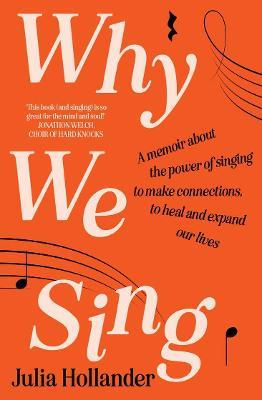Why We Sing by Julia Hollander
- NZ Booklovers

- Jul 19, 2023
- 3 min read

Did you know that when people sing together in a group, their hearts start beating at the same time? Or that singing actively stimulates the production of antibodies, and increases endorphin levels? Or that research comparing singing in a group with other group hobbies, such as craft-making and knitting, found those that sang were fastest in creating a sense of trust and affiliation, generating an almost instant feeling of positivity across the group?
I don’t really need science to convince me of the benefits of singing: I always warble my way through my day - shower, commute, making dinner - and meet regularly with a dedicated karaoke group; as a child I dreamed of being a singer when I grew up. (It transpires my enthusiasm was greater than my talent.)
And yet I loved reading this fact-filled, engaging memoir, as it affirmed how I feel about singing: it’s a soul-soothing, mood-boosting, connection-making, daily tonic.
As a music therapist, singing teacher and performer living in England, Julia Hollander’s work came to an abrupt standstill during the Covid pandemic, when singing - who’d have thought? - did a full 360 and suddenly became potentially harmful to one’s health. Hollander writes with wistful envy of watching English football fans serenading their teams while she was still unable to meet up with a community choir. (As a primary school teacher during this time, I could relate to Hollander’s bereftness about restrictions on being able to sing en masse; I made sure my class sang whenever we were outside, even if it was just while walking to the library.)
Having some time on her hands inspired Hollander to reflect and record this fascinating musical memoir, in which she weaves the latest scientific research into singing and music with her own life experiences: singing at climate change protests; training teenagers; religious songs, folk and traditional songs, singing while working (including a sensitively-handled contemplation on the songs of African slaves) offering musical therapy to dementia patients, long Covid sufferers, refugees.
Especially poignant is Hollander relaying her attempts at singing with her second child, who suffered irreversible brain damage after being deprived of oxygen at birth, the stress of which caused Hollander to suffer selective dysphonia. Although doctors told Hollander it would be impossible for her to experience an emotional state because she had no cortical pathways, she remains convinced her daughter’s “huh” that she emitted on the loudest beat of the bar, “perfectly synchronised with the singing” and hitting the key note, E, was in fact a joyful response to being played her (apparently) favourite song, ‘Everybody wants to be a Cat’ from Disney’s Aristocats.
The research she reports covers the cradle to the grave. Cradle: lullabies are recognisable as being such worldwide, even if you don’t speak the language it’s sung in; toddlers’ early musical experiences have a measurable impact on their later learning and are seen to contribute positively to the development of both vocabulary and maths skills. Grave: The concept of a ‘Swan Song’ - an artist’s final statement to the world - apparently originates in the whooper swan, whose extra-long tracheal loop can produce a drawn-out series of notes as its lungs collapse during death. Hollander recalls singing at the deathbeds of her second child, and a close friend’s mother, and to send-off a singing colleague at his funeral.
Reading this book, and sharing in Hollander’s passion, crooning has never seemed so magical: a natural, inbuilt antidote to our tech-heavy lives.
Reviewer: Stacey Anyan
Allen & Unwin



